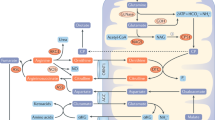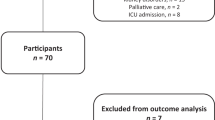Abstract
The refeeding syndrome is a potentially fatal condition that affects multiple organ systems. It is the consequence of fluid and electrolyte shifts that may occur in a malnourished patient following the introduction of nutrition therapy. The most prominent characteristic is hypophosphataemia. Although hyperammonaemia is usually seen in decompensated liver cirrhosis or acute liver failure, it may occur in other settings. We report a clinical case of prolonged and severe encephalopathy accompanied by hypophosphataemia and hyperammonaemia in a 59-year-old woman with no preexisting liver disease, urea cycle defects or portosystemic shunting. We suggest that these biochemical abnormalities were caused by uncontrolled refeeding and that the clinical picture was consistent with refeeding encephalopathy.
This is a preview of subscription content, access via your institution
Access options
Subscribe to this journal
Receive 12 print issues and online access
$259.00 per year
only $21.58 per issue
Buy this article
- Purchase on Springer Link
- Instant access to full article PDF
Prices may be subject to local taxes which are calculated during checkout


Similar content being viewed by others
References
Ormerod C, Farrer K, Harper L, Lal S . Refeeding syndrome: a clinical review. Br J Hosp Med (Lond) 2010; 71: 686–690.
Haberle J . Clinical and biochemical aspects of primary and secondary hyperammonemic disorders. Arch Biochem Biophys 2013; 536: 101–108.
Megarbane B, Guerrier G, Blancher A, Meas T, Guillausseau PJ, Baud FJ . A possible hypophosphatemia-induced, life-threatening encephalopathy in diabetic ketoacidosis: a case report. Am J Med Sci 2007; 333: 384–386.
Ardalan MR, Pourafkari L, Tubbs RS, Shoja MM . Hypophosphatemic encephalopathy in a CAPD patient. Am J Med Sci 2008; 335: 492–494.
Leroy S, Gout A, Husson B, de Tournemire R, Tardieu M . Centropontine myelinolysis related to refeeding syndrome in an adolescent suffering from anorexia nervosa. Neuropediatrics 2012; 43: 152–154.
Vilstrup H, Amodio P, Bajaj J, Cordoba J, Ferenci P, Mullen KD et al. Hepatic encephalopathy in chronic liver disease: Practice Guideline by the American Association for the Study of Liver Diseases and the European Association for the Study of the Liver. Hepatology 2014; 60: 715–735.
Morsy MR, Madina H, Sharaf SA, Soliman AT, Elzalabany MM, Ramadan MA . Hyperammonemia in Marasmic children. J Trop Pediatr 1994; 40: 97–99.
Grazer RE, Sutton JM, Friedstrom S, McBarron FD . Hyperammonemic encephalopathy due to essential amino acid hyperalimentation. Arch Intern Med 1984; 144: 2278–2279.
Felipo V, Minana MD, Grisolia S . Control of urea synthesis and ammonia utilization in protein deprivation and refeeding. Arch Biochem Biophys 1991; 285: 351–356.
Limketkai BN, Zucker SD . Hyperammonemic encephalopathy caused by carnitine deficiency. J Gen Intern Med 2008; 23: 210–213.
Acknowledgements
The authors thank Peter Ott for the valuable comments.
Author information
Authors and Affiliations
Corresponding author
Ethics declarations
Competing interests
The authors declare no conflict of interest.
Rights and permissions
About this article
Cite this article
Becker, S., Dam, G. & Hvas, C. Refeeding encephalopathy in a patient with severe hypophosphataemia and hyperammonaemia. Eur J Clin Nutr 69, 279–281 (2015). https://doi.org/10.1038/ejcn.2014.244
Received:
Revised:
Accepted:
Published:
Issue Date:
DOI: https://doi.org/10.1038/ejcn.2014.244
This article is cited by
-
Refeeding syndrome: multimodal monitoring and clinical manifestation of an internal severe neurotrauma
Journal of Clinical Monitoring and Computing (2021)
-
Acid–base disturbances may complicate the diagnosis of refeeding syndrome
European Journal of Clinical Nutrition (2015)
-
Refeeding encephalopathy revisited: Reply to Tasci et al.
European Journal of Clinical Nutrition (2015)
-
Zur Qualitätssicherung der Gewichtsrestitution bei Magersucht – Pathophysiologie, evidenzbasierte Praxis und Vermeidung des Refeeding-Syndroms
neuropsychiatrie (2015)



